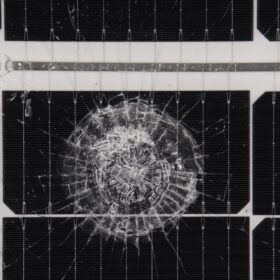US solar industry to add 502 GW (DC) of capacity in next decade
Wood Mackenzie warns that policy uncertainty could significantly alter its projections for US solar industry growth. The research firm says the US solar industry will add 502 GW (DC) of capacity over the next decade, with annual installations surpassing 40 GWdc through 2035.
Tariff uncertainty grips US battery development
The Trump administration’s China tariffs have piled atop existing and developing trade barriers on battery energy storage systems, components, and materials – destabilizing the US energy storage industry. While existing inventories will allow project development to move forward in the short term, uncertainty extends across the supply chain, including to prospective manufacturers.
New tool aims to cut costly hail losses in utility-scale solar
Hail damage accounts for just 2% of filed solar insurance claims but more than 50% of total costs, according to VDE Americas.
U.S. Commerce Department slaps unexpectedly high tariffs on solar imports
Coalition trade lawyer says the U.S. Department of Commerce’s final tariffs on solar cells and modules from Cambodia, Malaysia, Thailand and Vietnam are among the highest rates he’s ever seen.
Net metering policies see significant revision in states across the U.S.
The recent 50 States of Solar report from NC Clean Energy Technology Center identifies three trends in state policy activities and the top five distributed solar actions in Q1 2025.
How robotics is reshaping solar module installation
With module sizes increasing, labor shortages worsening and workplace safety risks escalating, automation is a necessity.
Avery Dennison debuts new pressure-sensitive tapes for PV modules
Avery Dennison has introduced a line of UV-resistant, pressure-sensitive adhesive tapes for PV modules. The new products support applications such as frame mounting, cell fixation, busbar bonding, and junction box installation.
California proposes break to rooftop solar contracts, raising average bills $63
Over one million California homes that invested in rooftop solar may have their net metering contracts rescinded under the proposed bill AB 942.
Teledyne Flir presents new PV inspection products
Teledyne Flir, a US-based sensing solutions company, has launched new PV inspection tools – including a clamp meter, irradiance meter, and I-V curve tracer – alongside two product kits targeting solar installers, utilities, and PV manufacturers.
Tariffs the least of U.S. solar market’s worries
While President Donald Trump’s sweeping levies on foreign imports have captured global headlines, antidumping and countervailing duty (AD/CVD) investigations into Southeast Asian products, along with a potential expansion of the Uyghur Forced Labor Prevention Act (UFLPA), could pose even greater risks for US solar and energy storage.










